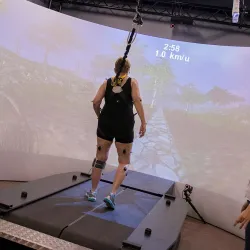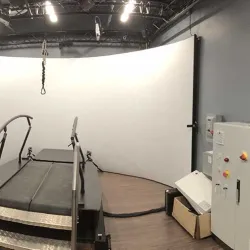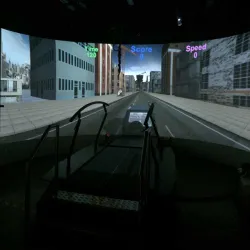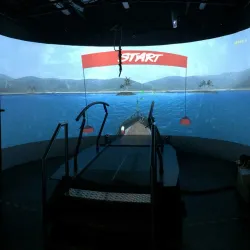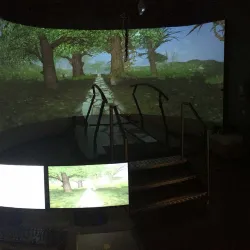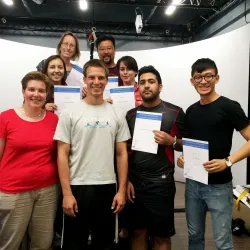Claire Honeycutt
-
-
Mail code: 9709Campus: Tempe
-
Claire Honeycutt is an assistant professor in the School of Biological and Health Systems Engineering at Arizona State University. Her primary career goal is to enhance mobility and quality of life in older adults and stroke survivors. More specifically her research focuses on the neural control of balance, reaching, and grasp with the long-term goal of developing targeted therapies and interventions that increase mobility, decrease falls, and enhance functional arm control in the elderly and stroke survivors. Her Human Mobility Laboratory merges her background in 1) neural control of movement 2) whole-body balance control, 3) aging, and 4) clinical populations to investigate the key neural mechanisms and factors contributing to falls in older adults and stroke survivors with the long term goal of developing task-specific training paradigms that decrease falls in these communities. In addition to the above project, her laboratory focuses on understanding the neural control of reaching and grasping in both healthy and neurologically impaired individuals.
Ph.D. Biomedical Engineering, Georgia Institute of Technology and Emory School of Medicine, Atlanta 2009
Honeycutt's Human Mobility Lab
Enhancing human mobility
There are two major research thrusts of the Human Mobility Lab: fall prevention and enhancing arm function. Our main objective is to work with clinicians to enhance rehabilitation strategies at the hospital, clinic, and home. Below you will find an overview of our research projects. Please contact Dr. Honeycutt if you are interested in learning more about our research. We embrace collaborations and look forward to hearing from you.
A balancing act -- a vaccine against falls?
Falls are one of the most common medical complications in older adults and neurological disease and injury patients. While many of us have fallen in our youth, falls in older adults are associated with significant disability, long and difficult rehabilitation, and death. Our primary objective is to understand what causes falls, identify those people most likely to fall, and develop interventions to prevent falling. Dr. Honeycutt’s long term goal is to develop an effective and time-efficient therapy program that individuals can go to the clinic or possibly their own gym to complete. The hope is that this treatment can act like a “vaccine” against falls.
We have a state-of-the-art system for the evaluation of balance, gait, and falls. An instrumented, split-belt treadmill with an integrated virtual reality environment allows detailed kinematic and kinetic measurements. In addition to this system, we have a fully equipped gait lab for evaluating gait, trips, and slips in a more natural environment. As part of a collaborative group of scientists at ASU including Thumon Lockhart and Jimmy Abbas, we strive to enhance mobility of all adults.
Startling insights
The Human Mobility Lab’s second major thrust is aimed at understanding motor planning during reaching and grasping movement. Movement is made up of two distinctive phases: planning and execution. The startle reflex is a new, non-invasive probe that allows us to evaluate the planning process in humans and patient populations. Further, this tool also allows us to evaluate the role of the brainstem in movement planning – something that until recently was only possible with complex electrophysiological recordings in animals. We use robots, virtual reality systems, and electromyography to evaluate motor planning both in unimpaired individuals and patient populations.
Subject recruitment
We are always looking for volunteers who are interested in participating in our experiments as human subjects. Here’s a list of our ongoing studies.
- Research for understanding neural and muscular activities during a treadmill perturbation.
Falls are associated with significant disability, long and difficult rehabilitation, and death. Our primary objective is to understand the neural and muscular activities when someone is trying to regain balance after a treadmill perturbation.
Your participation is voluntary. If you decide to participate in this study, you will be asked to walk/stand on a treadmill and we will record your movements in order to find out how you maintain your balance in different conditions. This study will be conducted in Human Mobility Laboratory (PEBE 158 on ASU tempe campus) and will take approximately 2-3 hours.
In this study, we are actively recruiting older adults (55+), stroke survivors and young adults. Contact Claire Honeycutt for more information.
-
Research for understanding movement planning & learning.
If you decide to participate, you will be asked to perform reaching tasks using a clinical robot to different types of sounds. The study will be conducted in PEBE building on ASU Tempe Campus and will take between 2-3 hours. Participation is voluntary. You will be compensated for your time.
In this study, we are actively recruiting stroke survivors. Contact Claire Honeycutt for more information.
Besides the Principle Investigator, Claire Honeycutt, we have a number of other people conducting research in the lab, including a technician and several undergraduate and graduate students.
We are always recruiting for motivated undergraduate and master’s students in the lab.
There are occasional PhD and Postdoctoral positions available. Please contact Dr. Honeycutt with a CV and a statement of interest.
- Honeycutt CF, Tresch UA, Perreault EJ (2015). Startling acoustic stimuli can evoke fast hand extension movements in stroke survivors. Clinical Neurophysiology. 126 (1), Jan. 160-164. In Press: PMID: 25002367.
- Tresch UA, Perreault EJ, Honeycutt CF (2014). Startle evoked movement is delayed in older adults: implications for brainstem processing in the elderly. Physiological Reports. Jun 6;2(6). PMID: 24907294.
- Honeycutt CF and Perreault EJ (2013). Deficits in startle-evoked arm movements increase with impairment following stroke. Clinical Neurophysiology. In Press: PMID: 24411525.
- Honeycutt CF and Nichols TR (2013). The mechanical actions of muscles predict the direction of muscle activation during postural perturbations in the cat hindlimb. Journal of Neurophysiology. PMID: 24304861
- Honeycutt CF, Kharouta M, and Perreault EJ (2013). Reticulospinal contributions to coordinated finger movement in humans. Journal of Neurophysiology. PMID: 23825395
- Ravichandran VJ*, Honeycutt CF*, Shemmell J, Perreault EJ (2013). Instruction-dependent modulation of the long-latency stretch reflex is associated with indicators of startle. Exp. Brain Research. Sep;230(1):59-69. PMID: 23811739 *authors contributed equally
- Trumbower RD, Finely J, Shemmell J, Honeycutt CF, Perreault EJ (2012). Bilateral impairments in task-dependent modulation of the long-latency stretch reflex following stroke. Clinical Neurophysiology. 2013 Jul;124(7):1373-80. PMID: 23453250
- Honeycutt CF and Perreault EJ (2012). Movement planning and execution following stroke: insights from the startle reflex. Plos One 7(8): e43097. PMID: 22952634
- Honeycutt CF, Nardelli P, Cope TC, Nichols TR (2012). Muscle spindle responses to horizontal support surface perturbation in the anesthetized cat: Insights into the role of autogenic feedback in postural control. Journal of Neurophysiology 108(5): 1253-61. PMID: 22673334
- Honeycutt CF and Nichols TR (2010). Disruption of cutaneous feedback alters magnitude but not direction of muscle responses to postural perturbations in the decerebrate cat. Experimental Brain Research 203(4): 765-71. PMID: 20473753
- Honeycutt CF and Nichols TR (2010). The decerebrate cat generates the essential features of the force constraint strategy. Journal of Neurophysiology 103(6): 3266-73. PMID: 20089811
- Honeycutt CF, Gottschall JS, Nichols TR (2009). Electromyographic responses from the hindlimb muscles of the decerebrate cat to horizontal support surface perturbations. J Neurophysiolgy 101: 2751-2761. PMID: 19321638
- Honeycutt,Claire*. Mechanisms underlying impaired postural corrections following stroke. HHS-NIH(1/1/2015 - 1/31/2018).
Courses
2024 Summer
| Course Number | Course Title |
|---|---|
| BDE 792 | Research |
| MAE 792 | Research |
2024 Spring
| Course Number | Course Title |
|---|---|
| BME 493 | Honors Thesis |
| MAE 792 | Research |
| BDE 799 | Dissertation |
| MAE 792 | Research |
| BDE 792 | Research |
| BME 235 | Physiology for Engineers |
| BDE 795 | Continuing Registration |
| BDE 799 | Dissertation |
2023 Fall
| Course Number | Course Title |
|---|---|
| BME 492 | Honors Directed Study |
| MAE 792 | Research |
| MAE 795 | Continuing Registration |
| BME 492 | Honors Directed Study |
| BME 394 | Special Topics |
2023 Summer
| Course Number | Course Title |
|---|---|
| BDE 792 | Research |
| MAE 792 | Research |
| MAE 792 | Research |
2023 Spring
| Course Number | Course Title |
|---|---|
| BME 493 | Honors Thesis |
| MAE 792 | Research |
| BDE 799 | Dissertation |
| MAE 792 | Research |
| BDE 792 | Research |
| BDE 795 | Continuing Registration |
| BDE 799 | Dissertation |
| BME 598 | Special Topics |
2022 Fall
| Course Number | Course Title |
|---|---|
| BME 492 | Honors Directed Study |
| MAE 792 | Research |
| MAE 795 | Continuing Registration |
| BME 235 | Physiology for Engineers |
| BME 235 | Physiology for Engineers |
2022 Summer
| Course Number | Course Title |
|---|---|
| BDE 792 | Research |
| MAE 792 | Research |
| MAE 792 | Research |
2022 Spring
| Course Number | Course Title |
|---|---|
| BME 493 | Honors Thesis |
| MAE 792 | Research |
| BDE 799 | Dissertation |
| MAE 792 | Research |
| BME 235 | Physiology for Engineers |
| BME 235 | Physiology for Engineers |
| BDE 792 | Research |
| BDE 792 | Research |
| BDE 795 | Continuing Registration |
| BDE 799 | Dissertation |
2021 Fall
| Course Number | Course Title |
|---|---|
| MAE 792 | Research |
| MAE 795 | Continuing Registration |
| BME 235 | Physiology for Engineers |
| BME 235 | Physiology for Engineers |
| BME 492 | Honors Directed Study |
2021 Summer
| Course Number | Course Title |
|---|---|
| BDE 792 | Research |
| MAE 792 | Research |
| MAE 792 | Research |
2021 Spring
| Course Number | Course Title |
|---|---|
| MAE 792 | Research |
| BDE 799 | Dissertation |
| BME 394 | Special Topics |
| BDE 792 | Research |
| BME 598 | Special Topics |
2020 Fall
| Course Number | Course Title |
|---|---|
| BME 492 | Honors Directed Study |
| BME 493 | Honors Thesis |
| BME 592 | Research |
| BME 599 | Thesis |
| BME 792 | Research |
| MAE 792 | Research |
| MAE 795 | Continuing Registration |
| ASU 101-BME | The ASU Experience |
| BME 235 | Physiology for Engineers |
| BME 493 | Honors Thesis |
| BME 492 | Honors Directed Study |
| BME 394 | Special Topics |
| BME 394 | Special Topics |
| BME 394 | Special Topics |
| BME 394 | Special Topics |
| ASU 101-BME | The ASU Experience |
| ASU 101-BME | The ASU Experience |
2020 Summer
| Course Number | Course Title |
|---|---|
| BDE 792 | Research |
| MAE 792 | Research |
| MAE 792 | Research |
2020 Spring
| Course Number | Course Title |
|---|---|
| BME 792 | Research |
| BME 493 | Honors Thesis |
| BME 592 | Research |
| BME 492 | Honors Directed Study |
| BME 599 | Thesis |
| MAE 792 | Research |
| BME 394 | Special Topics |
| BME 394 | Special Topics |
| BDE 799 | Dissertation |
| BME 492 | Honors Directed Study |
| BME 394 | Special Topics |
| BDE 792 | Research |
| BME 493 | Honors Thesis |
| BME 598 | Special Topics |
| BME 394 | Special Topics |
2019 Fall
| Course Number | Course Title |
|---|---|
| BME 492 | Honors Directed Study |
| BME 493 | Honors Thesis |
| BME 592 | Research |
| BME 599 | Thesis |
| BME 792 | Research |
| MAE 792 | Research |
| MAE 795 | Continuing Registration |
| BME 235 | Physiology for Engineers |
| BME 235 | Physiology for Engineers |
| BME 493 | Honors Thesis |
| BME 492 | Honors Directed Study |
| BME 394 | Special Topics |
| BME 394 | Special Topics |
| BME 394 | Special Topics |
| BME 394 | Special Topics |
2019 Summer
| Course Number | Course Title |
|---|---|
| MAE 792 | Research |
| MAE 792 | Research |
2019 Spring
| Course Number | Course Title |
|---|---|
| BME 792 | Research |
| BME 493 | Honors Thesis |
| BME 592 | Research |
| BME 492 | Honors Directed Study |
| BME 599 | Thesis |
| MAE 792 | Research |
| BME 394 | Special Topics |
| BME 394 | Special Topics |
| BME 492 | Honors Directed Study |
| BME 394 | Special Topics |
| BDE 792 | Research |
| BME 493 | Honors Thesis |
| BME 598 | Special Topics |
| BME 394 | Special Topics |
